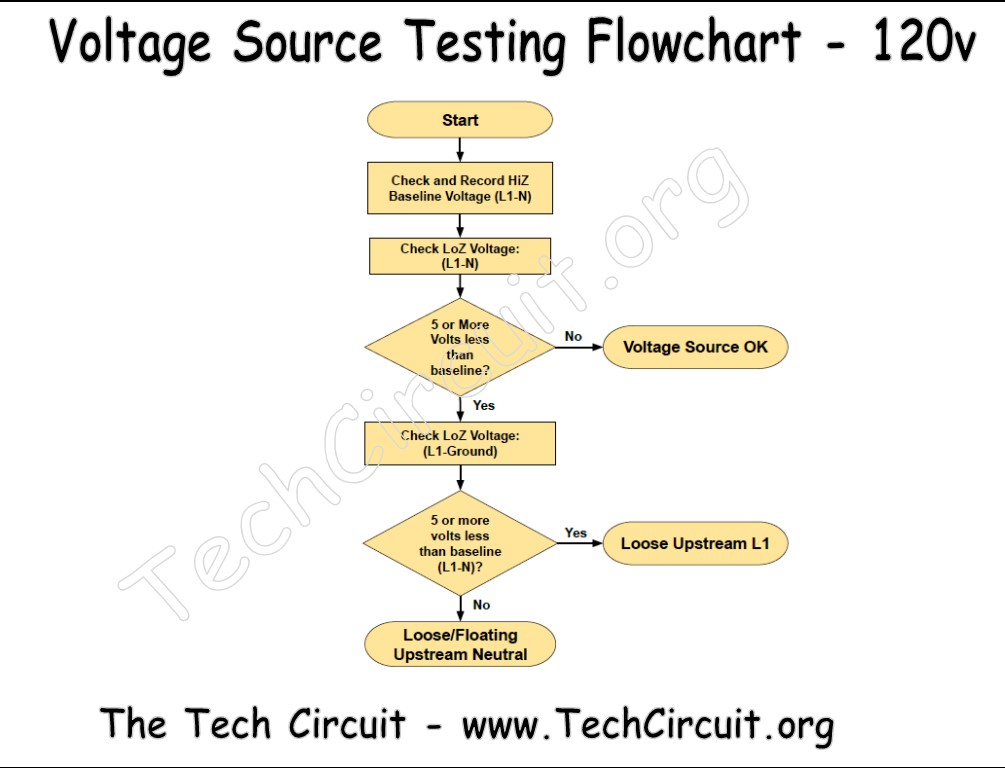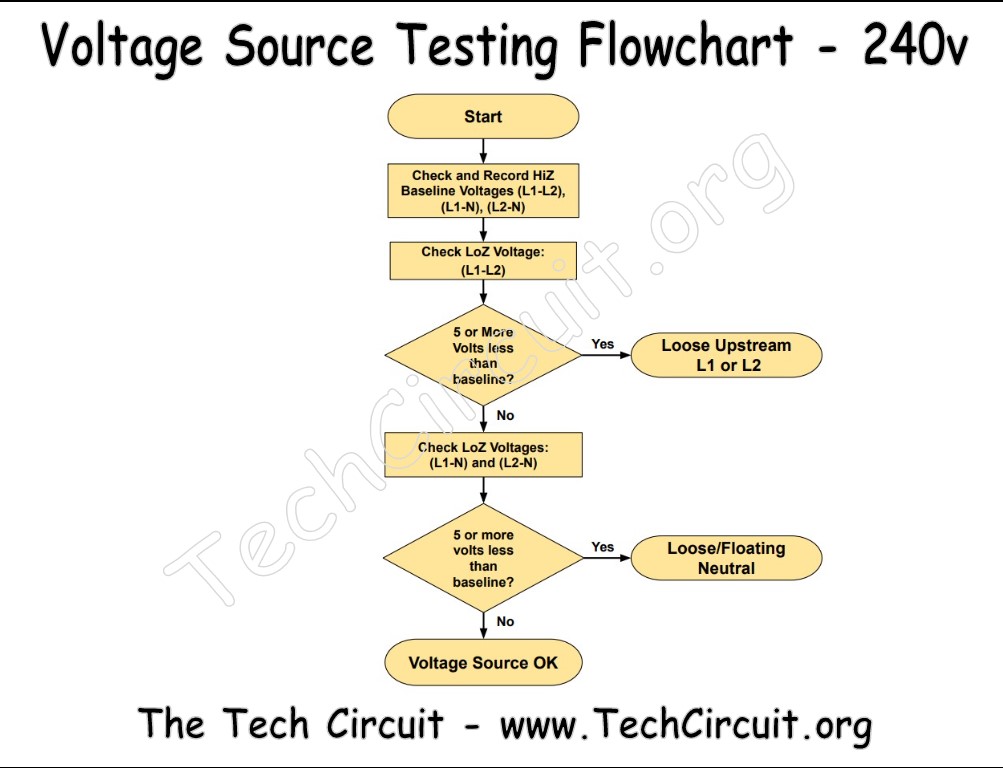This blog describes a quick way to determine if you have an incoming voltage problem that is causing appliance issues. By using the provided flowchart and a LowZ meter, you can accurately identify if you have a compromised voltage source related to L1, L2, or Neutral. I have seen many approaches to determining compromised voltage sources, but by following the process described herein, you can confidently determine if you have a voltage problem and proceed accordingly. THIS BLOG IS INTENDED FOR APPLIANCE TECHNICIANS ONLY. ALWAYS USE APPROPRIATE SAFETY PRECAUTIONS WHEN WORKING WITH ELECTRICITY.
*CLICK HERE FOR A RECOMMENDED LoZ METER*
Do I Have a Voltage Problem?
The LoZ meter applies a load to the circuit you are testing, allowing you to compare it with the “no-load” voltage. This comparison helps you determine if you have an upstream loose connection. Here’s how you can do it:
120v Testing Flowchart & Methodology (non-GFCI circuits)

Let’s go through the 120v flowchart:
- Check and record baseline voltage. Use your normal (HiZ) voltage testing mode to do this. This is your “non-loaded” voltage. Make a note (mental or otherwise) of these so you can compare it to your loaded (LoZ) voltage. The difference between the two will be the basis for the flowchart decisions.
- Use LoZ to check the voltage from L1 to Neutral. If you read approximately what you read with HiZ, then your voltage source is OK. Stop Here.
- If the voltage between L1 to N is greater than approximately 5 volts less than your baseline voltage, you have problem. Go to the next step.
- Check the voltage from L1 to Ground using LoZ mode. If you are reading a greater than approximately 5 volt difference than the baseline voltage between L1 to N, then you have a loose upstream L1. Stop Here. (note that this step cannot be used with a GFCI circuit because it will cause the circuit to trip – see footnote below for alternate method).
- If the voltage reading in step #4 is approximately that of your HiZ reading between L1-N, then you have a loose/floating upstream Neutral line. Stop here.
Note: When testing a GFCI circuit, step 4 can be replaced by plugging a load into the outlet (such as an incandescent lamp, hair dryer, or toaster), and measuring the voltage between ground and neutral in non-LoZ mode (traditional mode). If neutral is compromised, it will rise toward the level of L1. If L1 is compromised, it will drop toward ground potential.
*CLICK HERE FOR A RECOMMENDED LoZ METER*
240v Flowchart & Methodology (3 and 4 wire voltage sources)

Let’s go through the 240v flowchart:
- Check and record baseline voltage. Use your normal (HiZ) voltage testing mode to do this. These are your “non-loaded” voltages. Make a note (mental or otherwise) of these so you can compare them to your loaded (LoZ) voltages. The difference between the two will be the basis for the flowchart decisions.
- Use LoZ to check the voltage from L1 to L2. If you read approximately 5 or more volts less than your baseline, then you have a loose upstream L1 or L2. You can then use LoZ and compare each of those w/r to Neutral to determine which one is compromised. Stop here.
- If the voltage between L1 to L2 approximately matches your baseline reading, then L1 and L2 are Ok. Go to the next step.
- If L1 to L2 read Ok, then check the voltage from L1 to N and L2 to N using LoZ mode. If you are reading a voltage that is approximately 5 or more volts than their respective baselines, you have a loose or floating upstream neutral. Stop here.
- If all voltages approximately match your baseline voltages, your voltage source is Ok.
*CLICK HERE FOR A RECOMMENDED LoZ METER*
Summary
The techniques presented in this blog are designed to assist you in identifying whether the issue lies within the voltage source or the load, such as an appliance. These methods will offer a considerable degree of certainty in your assessment, allowing you to confidently proceed to the subsequent phase, which may involve consulting an electrician or further investigating the problematic appliance.
To DONATE to the Tech Circuit – CLICK HERE
Alphabetical Links to all Tech Circuit Articles and Blogs – CLICK HERE
Links to all Tech Circuit Cheat Sheets/Field References for Appliance/HVAC Techs – CLICK HERE
For additional electrical and electronics learning material for field techs, visit our homepage at http://www.TechCircuit.org or our Facebook group at https://www.facebook.com/groups/746823709133603, or our YouTube Channel
at https://www.youtube.com/c/TheTechCircuit
We are a participant in the Amazon Services LLC Associates Program, an affiliate advertising program designed to provide a means for us to earn fees by linking to Amazon.com
